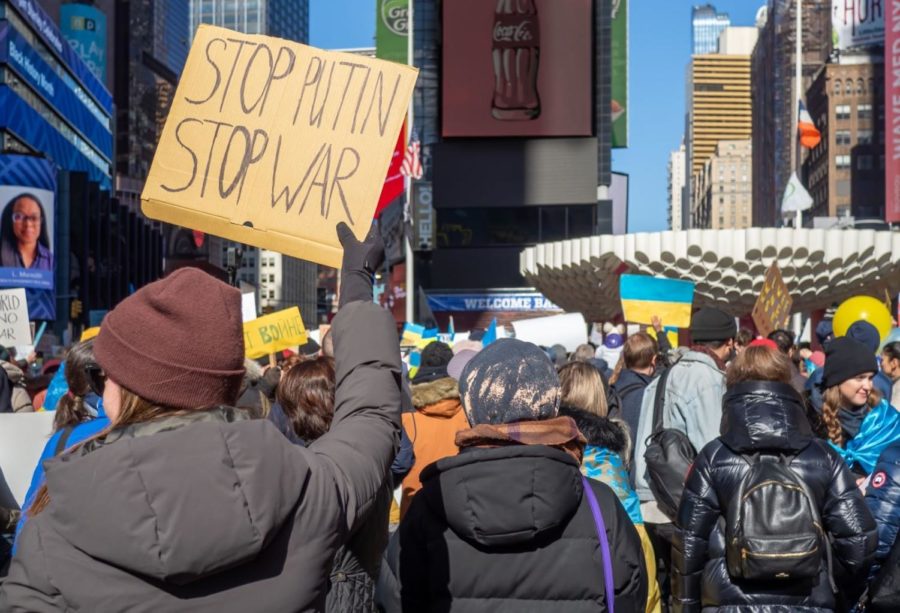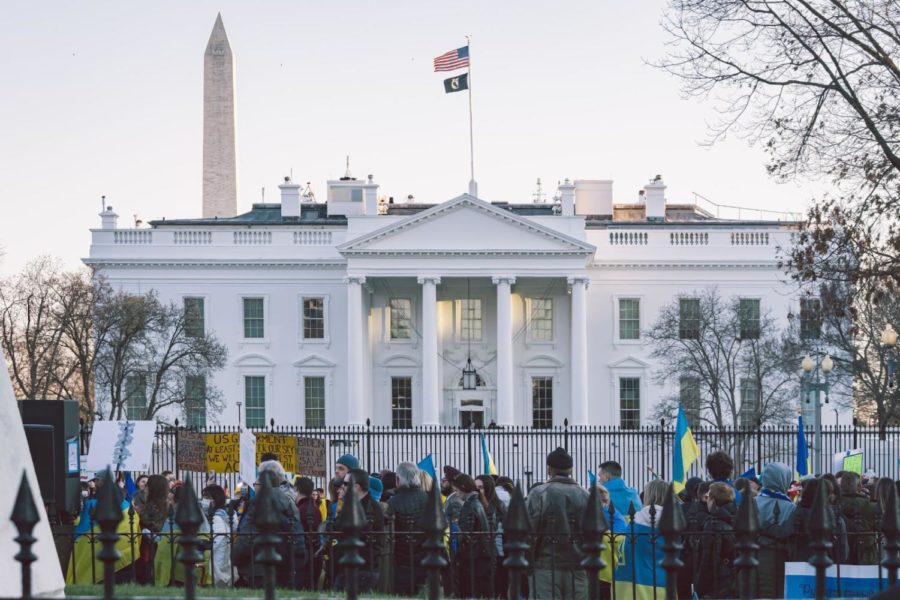From Tensions To Battles: A Timeline of the Russian Ukraine War
There have been many battles since Russia started its full scale invasion of Ukraine in February of 2022, and tensions go back to decades ago.
On February 24th, 2022, the world watched as Russia launched a full-scale invasion of Ukraine. For many people, this act was sudden. For others, this was expected.
Ukraine used to be part of the communist superpower, the Soviet Union, up until it gained independence on December 1st, 1991. On December 5th, 1994, Ukrainian leaders signed The Budapest Memorandum. This pledged Ukrainian security from the U.S., U.K., and Russia because of the country’s association with the Nonproliferation of Nuclear Weapons (NPT).
In the 2004 presidential election, Viktor Yanukovych was declared the fourth president of Ukraine. However, the victory didn’t last long, as numerous accusations of fraud emerged not long after. These accusations led many to protest in Kyiv, the capital of Ukraine. These protests led to what is now called The Orange Revolution, which started in November of 2004 and ended in December of that same year.
At the beginning of 2008, there were talks about Ukraine joining the North Atlantic Treaty Organization, more commonly known as NATO. Russian President Vladimir Putin made his opposition public, stating that Ukraine is “not even a real nation state.” Although it still wishes to join NATO, Ukraine hasn’t been able to in part because of Russian opposition.
It is no secret that Putin holds disdain for Ukrainian sovereignty, stating directly that the country’s history is intertwined with Russia’s, which is backed up by his claim that Ukraine is a part of Russia’s “history, culture, and spiritual space.”
During its time in the Soviet Union, Ukraine underwent many tragedies, with one of the most memorable being the Holodomor. The Holodomor was a man-made famine that occurred from 1932 to 1933, and resulted in anywhere from 3 to 7 million deaths. Many countries have recognized the Holodomor as a genocide, but Russia denies the occurrence of the famine altogether. This is just one of many reasons Ukrainians are fighting so hard against Russia’s takeover.
Between November 2013 to February 2014, protests spread about the perceived corruption of the government, with at least 130 people killed. Following these demonstrations , Russia grew angry, and in a show of force, seized the Crimean peninsula.
Pro-Russian separatists seized control of government buildings in Eastern Ukraine in late 2014, signaling the beginning of the conflict.
The current president of Ukraine, Volodymyr Zelenskyy, was elected on April 21st, 2019. President Zelenskyy was a former comedian, with his campaign consisting of promises to end corruption and war in Ukraine, but critics say he has achieved neither in his four years of presidency.
In 2021, Putin increased the number of troops at the Ukrainian border. He published an article about how, once again, Ukrainians and Russians are “one people.” In December, he issued a demand to NATO and the United States stating that Ukraine will never be a part of the treaty, which the Biden Administration denied.
This all leads back to the day we started with, February 24, 2022, when Russia commenced its invasion of Ukraine.
February 24-25, 2022: The Battle of Antonov Airport was one of the first attempts of the Russian government to take over Ukrainian land. During the battle, the world’s largest plane, The Antonov an-225, was destroyed. The fighting ended in a Ukrainian victory.
February 27, 2022: Russia started invading the city of Bucha as part of its plan to encircle Kyiv, the Ukrainian capital city.
March 2022: Refugees from Ukraine started gathering at Polish borders. As of now, there are believed to be over 8 million refugees from the country around the world.
March 6, 2022: Dozens of people in the Ukrainian town of Irpin trudged under a destroyed bridge to cross a river to evacuate. The town is still deemed unsafe, as it is in range of Russian arms.
March 9, 2022: An airstrike attack struck the Mariupol Maternity Hospital. The hospital was used as a maternity ward and a children’s hospital. Clips on the internet showed pregnant women walking out of bombed buildings into an opening full of destroyed cars and debris. Russian officials claim that the attack was justifiable, as apparently all staff and patients left beforehand and there were Ukrainian targets at the site. The attack resulted in at least four deaths, one stillbirth, and sixteen injured.
March 16, 2022: Russian forces bombed the Donetsk Academic Regional Drama Theatre in Mariupol, Ukraine. The theater was used for shelter during the siege of Mariupol. Over six hundred people died as a result of the bombing. The bombing consisted of two 500 kilograms (1,100 lb) bombs, which is considered a war crime.
April 1, 2022: Russian troops withdrew from Bucha in early April, leaving behind absolute destruction. Photos show bodies of civilians sprawled around streets, and people say there is evidence of executions and brutality. Russia made claims that the photos were fake and persecuted anyone who tried to speak up about it. As of February 2023, the town is undergoing repairs despite the lingering presence of Russian troops.
April 14, 2022: Ukrainian forces damaged the Russian warship Moskva with two R-360 Neptune anti-ship missiles, effectively making it catch on fire and sink. Russia reported 27 people missing with 200 injured. The ship was considered Russia’s most lethal warship.
May 17, 2022: A defense operation by Ukrainian soldiers was made to protect the Mariupol Steel Plant, a strategic industrial facility in Mariupol, Ukraine, from potential attacks by Russian forces.
September 1, 2022: Russian forces retreat or withdraw from the Kharkiv region in Ukraine, indicating a setback for their military operations.
September 21, 2022: Russia begins a partial mobilization, likely referring to an increase in military readiness and deployment of troops.
Sept. 21, 2022: Russian President Vladimir Putin orders the activation of reservists, indicating a significant escalation of the conflict and an expansion of Russia’s military capabilities. It increases the potential for more intense and prolonged fighting, raising concerns about civilian casualties, displacement, and further destabilization in the region. The activation of reservists also heightens the risks of broader regional and international involvement, as it signifies Russia’s unwavering commitment to its objectives.
Oct. 5, 2022: Russia officially incorporates four Ukrainian regions into its territory, likely through a unilateral declaration of annexation. By incorporating these regions, Russia asserts its control and authority over the territories, disregarding the sovereignty and territorial integrity of Ukraine. This unilateral action challenges the norms of international law and the principle of respecting the borders of sovereign nations.
Oct. 8, 2022: An explosion occurs on the Crimean Bridge, which connects the Russian mainland with the annexed Crimea. This incident provokes a retaliatory response from Russia. The Crimean Bridge, also known as the Kerch Strait Bridge, holds great strategic importance as a transportation route, enabling the flow of goods and people between mainland Russia and the Crimean Peninsula. The explosion of this crucial infrastructure is a highly disruptive event that disrupts the flow of traffic and commerce, impacting both the economies of Russia and Crimea. The incident itself raises questions about the perpetrators and their motives.
Oct. 10, 2022: Kyiv, the capital city of Ukraine, experiences a power outage, possibly as a result of military actions or infrastructure damage during the war.
Nov. 12, 2022: Ukrainian forces liberate the city of Kherson from Russian control, suggesting a successful military operation to regain control of the region.
Dec. 21, 2022: Ukrainian President Volodymyr Zelenskyy paid a visit to the White House to discuss the ongoing conflict and seek support from the US government.
Jan. 25, 2023: Germany and the United States jointly announce the sale of tanks to Ukraine, indicating international support for Ukraine’s military capabilities.
Feb. 2023: Russia initiates a new military offensive in Ukraine, suggesting an escalation of the conflict and renewed hostilities.
Feb. 20, 2023: United States President Joe Biden makes an unexpected visit to Kyiv, demonstrating solidarity with Ukraine and possibly providing political support in the face of Russian aggression.
June 6, 2023: One of Ukraine’s major dams, the Nova Kakhovka was destroyed. Satellite images show that the dam was already damaged on June 2nd. Ukraine and NATO have accused Russia of blowing up the dam but Russia claims it’s Ukraine’s fault. Thousands of people are evacuating places nearby the dam in fear that the flood would be disastrous. As of June 6, 2023, the cause of the destruction is unknown.
As fighting continues between the two countries, more people fear the outcome. Ukrainians do not want war, but it seems that’s all that Russia has in mind for them if they still want to remain an independent country.
In other parts of the world, many people continue to protest against this war. Protests have occurred everywhere, in many notable places like Germany, in front of the White House in Washington DC, and Times Square in New York. Hundreds of thousands of people gathered to protest against the invasion and to stand with Ukraine.
It has been over a year since the start of Russia’s invasion, and it’s not clear how long it will take to achieve lasting peace, but everyone is determined to stop the suffering and bring stability back to the region.
It has been over a year since the start of Russia’s invasion, and it’s not clear how long it will take to achieve lasting peace, but everyone is determined to stop the suffering and bring stability back to the region.
Rida Nuamah is a Copy Chief for 'The Science Survey' and enjoys writing about arts and entertainment. She finds journalistic writing appealing because...












